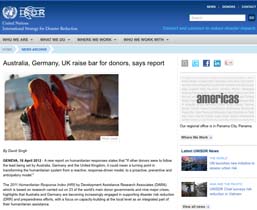April 16, 2012
Source: UN ISDR
GENEVA, 16 April 2012 – A new report on humanitarian responses states that “If other donors were to follow the lead being set by Australia, Germany and the United Kingdom, it could mean a turning point in transforming the humanitarian system from a reactive, response-driven model, to a proactive, preventive and anticipatory model.”
The 2011 Humanitarian Response Index (HRI) by Development Assistance Research Associates (DARA) which is based on research carried out on 23 of the world’s main donor governments and nine major crises, highlights that Australia and Germany are becoming increasingly engaged in supporting disaster risk reduction (DRR) and preparedness efforts, with a focus on capacity-building at the local level as an integrated part of their humanitarian assistance.
The HRI further highlights that the United Kingdom also has a revised humanitarian strategy which is now centred on how aid efforts, including development aid, can contribute to building resilience and anticipating future needs.
The report underscores however, that “DRR and prevention have been relegated to a grey area where no one takes ownership and leadership.”
According to the HRI, its findings confirm what previous reports have consistently revealed, “A persistent lack of political commitment and investment in capacity-building, conflict and disaster prevention, preparedness and risk reduction.”
“Part of the problem”, state the HRI, “is a narrow vision among donor governments of humanitarian assistance as emergency relief in the strictest sense, with everything else falling in the development assistance remit.” The flip side is that “most development assistance programmes fail to see risk reduction and prevention as part of their mandate”.
The HRI finds corroboration in another recent study – Disaster Risk Reduction: Spending where it should count by Jan Kellet and Dan Sparks – which estimates that less than one percent of all official government aid (ODA) – development or humanitarian assistance — is allocated towards preparedness activities.
The Kellet-Sparks study states that from 2000-2009 the 40 top recipients of humanitarian aid only received about 30 percent of total development aid ($363 billion out of $1.2 trillion) compared to 90 percent of all emergency aid. And just $3.7 billion was spent on DRR in the 40 countries surveyed.
According to the HRI, donors scored lower in prevention, risk reduction and recovery as well as in learning and accountability. Both pillars include indicators around greater participation and ownership of affected populations in the design and management of programmes, and longer-term approaches to capacity- and resilience-building.
“The inability of donors to respond in a timely manner to the drought and famine in Kenya and Somalia, despite ample early warnings, shows the devastating effects of inaction,” notes the HRI.
In the words of one of the respondents from Kenya quoted in the report: “We tried to propose something for early recovery but donors were not interested. They only want to fund emergencies”.
“The response to Haiti, Chad and Pakistan underline once again the importance of building local capacity and resilience, and … for prevention, preparedness and risk reduction”, notes the HRI.
And as one Haitian respondent quoted in the HRI states: “Most donors do not fund the transition to recovery and development. It is difficult to find donors once the emergency has passed over”.
The 23 donors surveyed by the HRI were Australia, Austria, Belgium, Canada, Denmark, European Commission, Finland, France, Germany, Greece, Ireland, Italy, Japan, Luxembourg, Netherlands, New Zealand, Norway, Portugal, Spain, Sweden, Switzerland, United Kingdom and the United States. The nine crises reviewed were Chad, Colombia, Democratic Republic of the Congo, Haiti, Kenya, The occupied Palestinian territories, Pakistan, Somalia and Sudan.

Share this